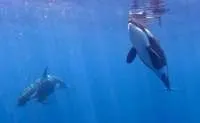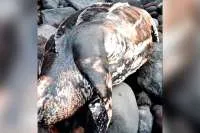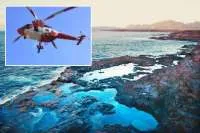VIDEO: Rare species of shark is spotted for the first time in Canary Islands waters
- 25-04-2025
- National
- Canarian Weekly
- Photo Credit: Marcos Hernández / Ramón Santana
- Video Credit: Marcos Hernández / Ramón Santana
A rare and enigmatic marine creature has made a surprising appearance in the Canary Islands. A goblin shark (Mitsukurina owstoni), a deep-sea species seldom seen by humans, was accidentally caught off the coast of San Cristóbal, Gran Canaria, during a recreational deep-sea fishing trip.
This is the first confirmed sighting of this species in the archipelago’s waters.
Fishermen Marcos Hernández and Ramón Santana, who were fishing at a depth of around 900 metres for local species such as hake and deepwater perch, found themselves face to face with an unexpected visitor. “When it came up, we had no idea what it was,” Hernández said. “At first, we thought it was a swordfish because of the snout, but then we realised it wasn’t. It had leathery skin, and after looking online, we understood what it really was.”
Known for its distinctive elongated beak and protrusible jaw, the goblin shark has an unusual, almost otherworldly appearance that evokes imagery more often seen in fantasy than science. The creature’s eerie, toothy visage and unusual body structure make it one of the most visually striking species of shark in the ocean.
The fishermen photographed the shark and carefully released it back into the sea, watching as it slowly recovered and swam back into the depths. The encounter was both rare and scientifically significant.
Experts Alberto Brito, an ichthyologist, and marine ecologist Asier Furundarena from the public company GESPLAN, issued a statement highlighting the importance of the discovery. They noted that the goblin shark is one of the most specialised and poorly understood sharks in the Canary Marine Demarcation, with no previous records of sightings in the region.
The species is characterised by its long, flattened snout resembling a spatula, highly extendable jaws with slender teeth adapted for grasping prey, and a caudal fin that constitutes nearly half the length of its body. Although it is widely distributed in temperate and tropical oceans, sightings are extremely rare and usually limited to specific, scattered regions. In nearby areas, the shark has been sporadically recorded in Madeira, Galicia, the Bay of Biscay, and Portugal, suggesting very small, elusive populations.
Goblin sharks typically inhabit the continental slope at depths between 250 and 950 metres, though they have been found as deep as 1,300 metres. They feed on small fish, squid, and crustaceans, which they capture by rapidly extending their jaws.
The species matures late, with males reaching sexual maturity at nearly three metres and females at even greater lengths. This slow growth and reproductive rate make the species especially vulnerable. They are ovoviviparous with oophagy, meaning embryos develop inside the mother and feed on unfertilised eggs during gestation.
Until recently, little was known about their reproductive biology, but the accidental capture of a pregnant female in Taiwan in 2023 provided new insight, she carried six near-term pups measuring 110–130 centimetres each.
Interestingly, most specimens found in the eastern Atlantic are juveniles or subadults, whereas larger specimens have been recorded in the western Atlantic. The largest known goblin shark was a female caught in the Gulf of Mexico in 2000, measuring around six metres long.
“This sighting, capturing such a magnificent creature on film and returning it safely to its habitat, is an extraordinary privilege,” Brito and Furundarena wrote. “It highlights the richness of the natural heritage hidden in the deep waters surrounding the Canary Islands, a legacy that deserves our respect, admiration, and protection.”
Other articles that may interest you...
Trending
Most Read Articles
Featured Videos
A Vision of Elvis Tenerife Promo
- 10-05-2025
TEAs 2025 Highlights
- 17-11-2025

























































